July 1, 2015
The uses of art in project Comboio, Favela Moinho, 31st Bienal de São Paulo
Written by Michelle Sommer
This paper critically discusses project Comboio at Favela Moinho, São Paulo, in the context of the 31st Bienal de São Paulo. The Comboio collective acts in “informal spaces” in the central area of São Paulo and describes itself as a project of research and urban intervention. The main goal is the affirmation of “the right to the city” that is built from the following points: public art, bottom-up micro urban planning, popular funding, ethics and citizenship. The collective has lived in the Favela Moinho since 2012. As the last remaining favela in central São Paulo, Moinho provides a crucial counterpoint in cultural terms and conditions to the Bienal, located in Ibirapuera Park. Can this be seen as a contemporary example of what Mario Pedrosa (1900-1981) called, in his criticism of art and politics, “experimental exercise of freedom”?
Favela Moinho resists
Favela Moinho is the last remaining favela in São Paulo´s central area. Recently, the settlement was the target of two suspected arsons
, after which its continued existence has become a symbol of resistance against property speculation and for housing rights in the most populated city of South America. Between the first and second fires, the local government of São Paulo built a 8 metre high wall – “the wall of shame”, as the community has called it – with the stated purpose of isolating the burned area from the rest of the inhabited area. Nowadays, 480 families have a temporary legal title to remain in Favela Moinho. The local political organization Movimento Moinho Vivo, created in 2013 through the initiative of dwellers and community partners, presently conducts studies with a view to building a participatory urbanization project
.
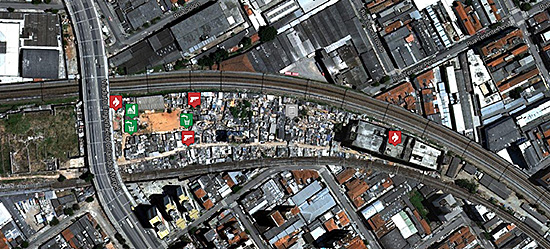
Comboio: mobile political activism in affirmative actions of the right to the city
Comboio defines itself "as a project (in action) of research and urban intervention, which since 2010 operates in 'informal spaces' in the center of São Paulo, seeking ways to exercise and assert the right to the city". The researches conducted in the intervention sites are run by real demands of the communities to create exercises of empowerment of the local actors and appropriation of underutilized space
. The main objective is to strengthen the relation of territorial belonging through the creation of interactive, inclusive and participatory public spaces inside communities.
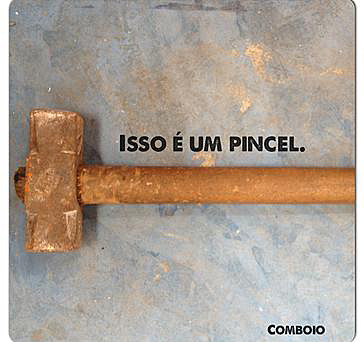
The project is structured in two phases, initiated in 2013, each of which resulted in the building of a public equipment: "The Public House" (phase 1) and “Vermelhão Park” (phase 2), carried out in partnership with Movimento Moinho Vivo. All interventions are directly funded by the community, without intermediaries, through donations of money and other resources used exclusively for the creation of these public spaces in the community. During the execution of these actions, Comboio and Movimento Moinho Vivo also co-organized the destruction of “the wall of shame” in August 2013, meeting the community's demand for an escape route in case of a new fire in the area.
The Public House became the main convergence space for the community, connecting various political and cultural actors, internal and external to the community. The four points in Comboio's methodology for the construction of Vermelhão Park
were (1) mobilization of the residents in order to gather materials and volunteer work for the project; (2) activation and mobilization of services by municipal agents; (3) popular funding (donation of funds and material resources)
; (4) T-shirt sales of Moinho Vivo. Project Comboio is still ongoing until this date.
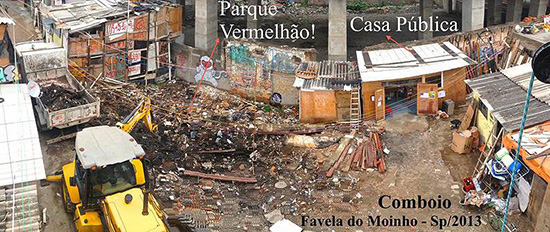
Comboio / Favela Moinho / 31st Bienal de São Paulo
The title of the 31st Bienal de São Paulo, “How to (…) things that don’t exist”, is a poetic invocation of art’s capacities, its ability to reflect and act upon life, power and belief. The curatorial text conjures up a state of turn in the contemporary condition and an attempt to find a way out of established parameters in order to give space to complexity and flexibility, without shying away from conflict and confrontation
. The emphasis is on process and collaborative action between individual and groups, on relationships that should continue and develop throughout, moving in the opposite direction to the closure (and imprisonment) of the biennial in itself.
The curatorial intention in establishing the collaboration between Comboio and the community of Favela Moinho in the context of the 31st Bienal de São Paulo was to explore art's ability to interfere in different contexts. As part of the 31st Bienal de São Paulo, Comboio and Moinho Vivo developed a series of cultural and educational public workshops, from September to November, 2014. In terms of presence in the exhibition context, after meetings between curators, artists and community to discuss whether and how to present materials relating to the project, it was decided that relevant phrases and slogans related to the community's struggle would be shown on a large glass panel in the Cicillo Matarazzo Pavilion at Ibirapuera Park, which houses the Bienal. The material shown was assembled by artists and community together.
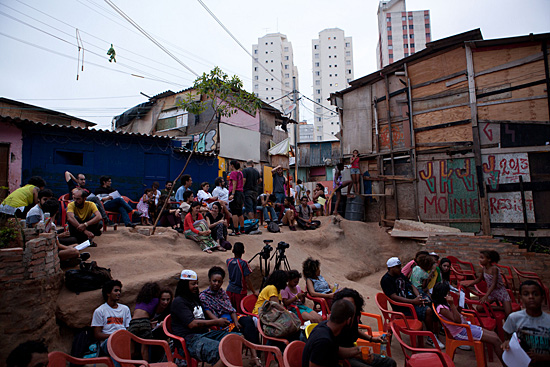
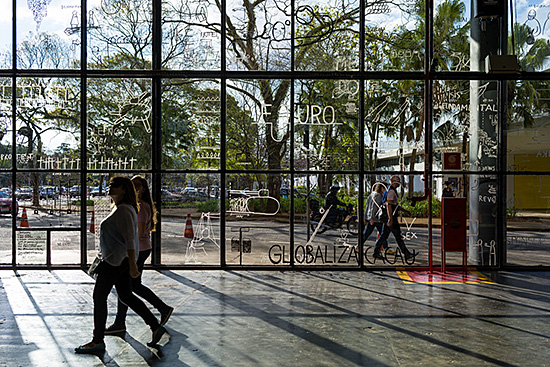
Social perspectives in Brazilian art: an “experimental exercise of freedom”, according to Mário Pedrosa
The emergence of political consciousness in the Brazilian art context dates back to the 1920s and 30s. Mario Pedrosa's (1900-1981) was one of the most important contributions for Brazilian social history of art
, and his work can still help us think through the preoccupations with the social dimension of art that, since the 2000s, have given rise to new strategies in the intersection between art and political activism in Brazil
.
For Mario Pedrosa the "experimental exercise of freedom" defined art in its refusal to become a merchandise,taking place in the form of acts, gestures and collective actions, ephemeral and environmental granted by openings in the “autonomy of art” and the capitalist system itself. Hence, “experimental exercise of freedom” is the minimal room for manoeuvre available for socially engaged artists under capitalism, to be preserved and enhanced.. In the 70s, already worried about the encroachment of the entertainment industry in art, Mário Pedrosa proposes political action through art as the only way to break the circle.
Almost half a century after Mario Pedrosa´s early identification of one of the fundamental conditions of the transition from the modern to the contemporary – the shift from the exclusive focus on the artwork to the the expanded focus on the artistic action –, Charles Esche, one of the curators of the 31st Bienal de São Paulo, takes up the idea of the opening provided by the autonomy of art to think it in relation to the institutional context. Esche argues that the art institutions can and should take on the role of agents in the reinvention of a decaying state. Esche's argument is thus quite similar to Mario Pedrosa's. According to both, the main question can be summarized in two points: the first one is the political function and possibility of protest inherent in art’s own autonomy; the second one is that pushing art beyond an exclusively aesthetic scope can produce an impulse towards social construction, and thus the possibility of some kind of rupture/revolution into the system. "If being creative, in the capitalist sense, is to imagine what does not exist for the creation of 'the new', why can art not imagine the society?”
If in Mario Pedrosa´s time his thoughts turned to the artistic tensions between the symbolic and the useful, nowadays, when the social practice of art is consolidated, the researches move on to discuss possibilities of action.
If, as the Cuban artist Tania Bruguera asserts, we can already put Duchamp's urinal back in the bathroom, it is also important not to forget that this possible return does not invalidate the achievements of his previous actions, and to keep in mind that all actions that fall under the concept of “useful art” are not automatically, or more efficiently, anti-capitalist.
The collaboration among projects that have different temporalities generates a clash between the long and the short term. Favela Moinho has a history before, during and (we hope) after project Comboio. In turn, Comboio is a long-term project in relation to the Bienal and biennial models in general. The insertion of the discussion of an artistic social practice in an institutional context such as a biennial can be an accelerationist "kick" to the internal dynamics of an ongoing collective action by binding the different temporalities into a single, coinhabited time. This coinhabited time is what Bruno Latour would call "the great Complicator", where the shared democratic space is understood as time publicly in common, as opposed to independent time frames.
In the structural context of the biennial exhibition model, the criterion for the discussion of what to present of artistic social practice is not itself aesthetic. It is rather a matter of what and how to convey the density of information of an artistic social practice taking place in a space / time outside the institution. Taking the distinction proposed by Draxler (2014, p. 10) between two particular categories of artistic practices – the exhibitionary and the discursive – Comboio / Favela Moinho is a discursive action communicating a new challenge for insertion of these practices at the institutional level.
The insertion of artistic social practices in institutional spheres is one of the possible "uses of the institution" that expand its ability to function as a platform for critical thinking and social change. Art can and should go beyond the spaces traditionally ascribed to it, be they the studio, the gallery, the museum or alternative spaces. On the other hand, there is no way of saying in advance whether the "kicks" involved in bringing artistic social practices into institutional settings will benefit the community itself; such mediations are not good or bad per se, but need to be evaluated and reconsidered case by case.
Michelle Sommer is a curator and currently a PhD candidate in Art History, Theory and Critique at the Rio Grande do Sul Federal University. The research presented in this article was largely funded by the Brazilian CNPq (National Research Council).
------------------------------------------------
[1] Favela Moinho started 25 years ago with the occupation of the urban land under the overpass where was located the Matarazzo mill (moinho), which earned it the name. About the history of Favela Moinho: Arquitetura da Gentrificaçao - http://reporterbrasil.org.br/gentrificacao , accessed April 9, 2015.
[2] In 2011, the first fire destroyed a third of the community and left 600 people homeless. In 2012, the second fire consumed 80 homes and injured several people. Before the two large fires, the community was inhabited by 1,200 families (around 5000 people). The fires in the Brazilian favelas are not isolated cases, but rather a systemic problem connected to land speculation. In São Paulo, between 2005 and 2012, more than 800 fires were registered. Source: Movimento Passe Livre São Paulo - http://saopaulo.mpl.org.br , accessed April 9, 2015.
[3]About Favela Moinho / Movimento Moinho Vivo: https://moinhovivo.milharal.org/ and https://www.facebook.com/moinhoresiste , accessed April 9, 2015.
[4] Comboio was involved at the following occupations: Ocupação Sérgio Buarque de Holanda (2007), Ocupação Prestes Maia and São João (2010) and Ocupação Cambuci (2012), all of them in São Paulo. Comboio is coordinated by artists Caio Castor and Flavia Lobo de Felicio. About Comboio: http://projetocomboio.wix.com/projetocomboio, accessed April 9, 2015.
[5] The project involves the memory of the residents in relation to their own knowledge and technologies. The common spaces were built using materials locally available or collected in the immediate surroundings.
[7] The Public House was inaugurated in June, 2013. The project´s accounts can be acessed at: http://projetocomboio.wix.com/projetocomboio#!transparncia/c1sil , accessed April 9, 2015.
[8] "Vermelhão Park" had become a garbage dump, reduced to rubble and ashes by the September 2012 fire. Until this time, the place was used by children as a playing area.
[9] On December, 2013 the Movimento Moinho Vive and the Comboio made an independent campaign to collect resources (materials, tools and money) to build the "Vermelhão Park".
[10] http://www.31bienal.org.br/en/information/766,acessed April 9, 2015.
[11] “This is not a Bienal built on art and objects, but on people working with people on projects, on collaborations between individuals and groups, on relationships that should continue and develop throughout and, perhaps, even after the 31st Bienal is over. While a small group of people might be the initiators, the stress of the 31st Bienal is on all those who will be in contact with the project and make use of it, and on what the encounters with the projects and the event as a whole will create. The openness of the process needs to be understood in terms of a process of learning: an educational exchange that is established throughout and on each level and therefore unresolved and exploratory”. The curatorial text can can be acessed at: http://www.31bienal.org.br/en/information/766 , acessed April 9, 2015.
[12] The activities were: sidewalk drawing workshop, planting and gardening workshop, electrical workshop, toy workshop , urban furniture workshop and a concert at Favela Moinho.
[13] AMARAL, A. Amaral. Arte para quê? A preocupação social na arte brasileira (1930-1970). São Paulo: Nobel, 1984.
[14] Mario Pedrosa was a journalist, professor, art critic, curator, writer, collaborator of the Bienal de São Paulo Foundation and MAM-RJ (Rio de Janeiro Museum of Modern Art), socialist activist and leader. He opened a way for Trotsky´s thought in Brazil and, symbolically, signed the first membership card of the Workers' Party, in 1980, one year before his death.
[15] The right to the city, housing rights and a new discussion about the meaning of the public and the private constitute the commom matrix for the following ongoing actions in Brazil: #ocupeestelita, Recife / PE; Ocuppy Parque Augusta, São Paulo / SP; Occupy Cais Mauá, Porto Alegre / RS; Vila Itororó, em São Paulo / SP. In the institutional context, MAR (Museu de Arte do Rio de Janeiro) is presently hosting the exhibition “Zona de Poesia Árida” , wich presents 55 artworks of art and activism collectives from São Paulo. About the project: http://www.museudeartedorio.org.br/pt-br/exposicoes/atuais?exp=2263 , acessed April 9, 2015.
[16] During his trajectory, Mário Pedrosa did not interpret the autonomy of art in the same way. In his early criticism, "proletarian art" and "utilitarian art" were used as terms of praise in relation to Kathe Kollwitz's work, in his first published piece of criticism, "Social trends of art and Kathe Kollwitz," of 1933. Later, Pedrosa will become wary of the possible confusion between “proletarian art” and socialist realism, and will enhance its meaning to include the constant and updated renewal of means of expression and form.
[17] Idem.
[18] In order to move beyond the modern term of a reflexive subject – a concept for which the transition between passive and active participants in art is difficult to assess – it is necessary to consider the issue of time. More specifically, how public time is framed in order that a space of co-production can emerge. Latour, Bruno. “From realpolitik to dingpolitik or how to make thing public”. Cambridge, MA: The MIT Press, 2005.
[19] “The exhibitionary includes ways of arranging and presenting objects or displaying information; ways of addressing, assembling and guiding people; and ways of interacting symbolically with those objects of information via conversation, education, marketing or critique, in which the discursive has become a means of intervening into the exhibitionary situation through voiced debates and targeted questioning”. Exhibition as Social Intervention. “Culture in Action”, 1993. Joshua Decter, Helmut Draxler and other authors. Exhibition Histories. Afterall, Central Saint Martins, University of the Arts London, 2014, p. 10.









